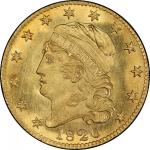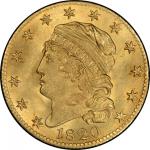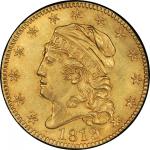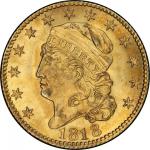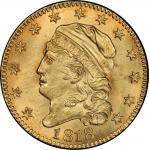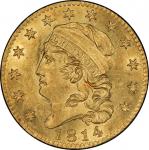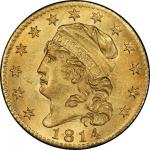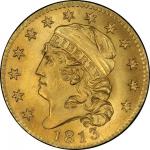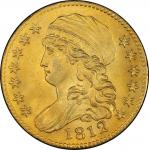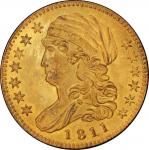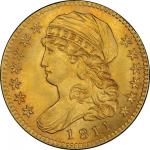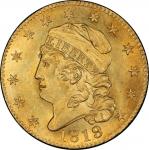“I think I mentioned to you that I once owned the collection, but a much more interesting fact I did not mention is that the pieces form the gold cabinet of Joseph J. Mickley. After purchasing his coins I sold the gold collection entirely, and now it has come back to me.” — W. Elliot Woodward to T. Harrison Garrett, January 18, 1883 Aglow with dense orange toning gathered while at rest in some of the most famous cabinets the world of American numismatics has ever known, this is the single finest known specimen of this date. The obverse is bright, somewhat reflective around the portrait, highly lustrous and ideally toned in medium yellow gold. The right side of the obverse has developed a wealth of attractive coppery toning. The reverse is a storm of satiny luster, deeply toned with mingled shades of dark yellow and bright orange, a visceral aesthetic delight. The strike is complete, bold everywhere and perfectly sharp on even the sometimes soft centers. Marks are minimal in both number and consequence, with two parallel nicks low on Liberty’s cheek topping the list of obverse severity and a little group of contact points confined to the central left reverse field. A few specks of transparent foreign matter, glue or something similar, are seen below N of UNITED above the outer pair of olive leaves, high on the wing at left at the border with the shield, and above the upper left corner of the shield in the field below the eagle’s neck. These are harmless and have undoubtedly been on the coin for untold decades, almost certainly since before this coin was acquired by T. Harrison Garrett in 1883. Within the reverse shield, the clash from the 1818 usage of this reverse remains visible, but the dies have been undamaged and unclashed since. A single long lapping line is present on the obverse right of star 12. The 5D/50 error remains easily seen. There may be no half eagle anywhere with a more august provenance. Joseph J. Mickley, sometimes called “the father of American coin collecting,” was among the best known serious numismatists in the United States when coin collecting became a national avocation in the late 1850s. Mickley began collecting sometime between 1816 and 1823; his friend William E. DuBois suggested the former date, while fellow Philadelphian Ebenezer Locke Mason offered the latter. All narratives of Mickley’s life agree, in the words of E.L. Mason in 1867, “he became desirous of obtaining a coin bearing the date of his birth, 1799; and being of an economical disposition, concluded a copper U.S. cent of that date would answer his purpose.” The search for a 1799 cent revealed two truths to Mickley: that 1799 was a rare date for cents, and that he had been bitten by the coin collecting bug. His collecting reached its zenith in the late 1850s, when he published Dates of United States Coins and Their Rarity, which Q. David Bowers has called “the first such general guide published in America.” In 1867, after suffering a robbery at his home, Mickley decided to sell his collection. W. Elliot Woodward bought the entire cabinet, roundly considered the finest ever built in the United States. A line item in Mickley’s diary, written shortly after the sale of his coins, referred to the purchase of $10,000 in bonds. Woodward paid at least that much, and probably more, for the group. William Sumner Appleton was Boston’s leading numismatist of this era. The son of a congressman, his wealth and connoisseurship led to the assembly of a world-class cabinet. Most of his coins and medals were given to the Massachusetts Historical Society upon his death in 1903. Though large portions, including his 1804 dollar, were deaccessioned and sold at auction in the 1970s and 1990s, his colonial coins, medals of George Washington, and other properties remain at the Society, forming one of America’s great institutional numismatic collections. Some modern scholars have suggested that Appleton was the silent partner in Woodward’s acquisition of the Mickley Collection, receiving Mickley’s gold coins as his profit on the deal. Whether by partnership or purchase, Appleton was the next owner of Mickley’s eagles, half eagles, and quarter eagles, including the coin presently offered. When W. Elliot Woodward set about offering a group of gold coins from the Mickley-Appleton group to T. Harrison Garrett in January 1883, another unidentified character appears in Woodward’s narrative. “Today I have seen the owner of the gold collection,” Woodward wrote to Garrett on January 17. A letter written the next day referred to “the man who owned the gold,” saying he had told Woodward “he would leave town that last night but should be at a store in the city until 6 p.m.” The retired patrician Appleton would have no use for hanging around a store all day, but a Boston merchant would. That merchant, and the dealer who bought the Mickley gold from Appleton, was John Schayer, who E.L. Mason described as occupying “a prominent position ... among the noted Boston numismatists.” In a September 1884 profile, Mason noted that Schayer “although engaged, like many of our American collectors, in mercantile pursuits ... has had in his possession some of the finest and rarest of American and foreign pieces.” Schayer was an alligator skin merchant; Mason noted that he “has been entitled ‘THE KING OF THE ALLIGATORS.’” Numismatically, Schayer was what would be termed today a wholesale dealer. Mason cited various transactions Schayer had been a party to, including the sale of “upwards of three thousand” half cents to Lorin Parmelee; Mason also pointed out that Schayer’s inventory included “vast numbers of the early gold eagles, half-eagles, and quarter-eagles.” In June 1882, about six months before Woodward sold this coin to T. Harrison Garrett, E.L. Mason placed a teasing comment about the Appleton gold in his house organ, Mason’s Coin Collectors’ Magazine. Mason had by then moved from Philadelphia to Boston, and he proceeded to become the town’s greatest numismatic gossip. A three line notice announced “W.S. Appleton, of Boston, has disposed of his gold eagles, half eagles, and quarter eagles to a Boston dealer, and it is rumored that Devon-schayer street has a share in the trade.” Schayer’s shop was on Devonshire Street, then and today in the heart of Boston’s mercantile district. Woodward may have been a party to the acquisition. A number of gold coins with provenance to Mickley were sold in Woodward’s May 1883 auction, possibly representing his share of the purchase or a consignment from fellow Bostonian Schayer. W. Elliot Woodward told Garrett the identify of the former owner of the gold coins in his January 18, 1883 letter. “Living close to the Mint and beginning early,” Woodward wrote, “Mickley had facilities for collecting superior to any other person, and he knew well how to avail himself of them.” Just where this 1819 half eagle came from is unknown, but Mickley had ferreted it out somewhere, placing it in his remarkable cabinet sometime between the 1830s and the 1860s. Since that time, every collection this coin has graced has been legendary: Mickley, Appleton, and T. Harrison Garrett occupy the top tier of 19th century American numismatists. Ted Naftzger and D. Brent Pogue occupy the top tier of numismatists who collected in the 20th and 21st centuries, both men of exacting taste and widespread reputation. David Akers wrote in 1981: “The Naftzger Half Eagle Collection is one of the finest collections of its kind ever assembled.” The D. Brent Pogue Collection of half eagles is even finer. The half eagles of 1819 are extraordinary rarities. The 5D/50 variety is the most numerous of the three die marriages, with a population that the Bass-Dannreuther book suggests is in the range of 16 to 20 specimens. Included in this number are two examples impounded in the National Numismatic Collection at the Smithsonian Institution and the Harry Bass Core Collection coin at the American Numismatic Association Museum. The Bass coin was first offered in the 1907 David S. Wilson sale, where the date was described as “excessively rare; only nine known to exist; the exceeding rarity of this date was not appreciated until the Smith sale.” Saul Teichman’s careful research has identified 14 provenance chains representing somewhere between 12 and 15 individual specimens. Since the Harry Bass duplicate sold in 1999, there have been just three offerings of this date at auction, including two of the same specimen. In all grades and representing all die varieties, PCGS has certified just eight examples of this date. Five 1819 half eagles are represented as Mint State on the PCGS Population Report, probably representing fewer individual coins. Two of those coins are included in the present offering, this specimen and the only Mint State 1819 Normal Reverse half eagle, offered in the following lot. PCGS# 8124. NGC ID: 25PS.



